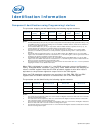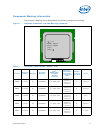
22 Specification Update
BV4. Performance Monitor SSE Retired Instructions May Return Incorrect
Values
Problem: Performance Monitoring counter SIMD_INST_RETIRED (Event: C7H) is used to track
retired SSE instructions. Due to this erratum, the processor may also count other types
of instructions resulting in higher than expected values.
Implication: Performance Monitoring counter SIMD_INST_RETIRED may report count higher than
expected.
Workaround: None identified.
Status: For the steppings affected, see the Summary Tables of Changes.
BV5. IRET under Certain Conditions May Cause an Unexpected Alignment
Check Exception
Problem: In IA-32e mode, it is possible to get an Alignment Check Exception (#AC) on the IRET
instruction even though alignment checks were disabled at the start of the IRET. This
can only occur if the IRET instruction is returning from CPL3 code to CPL3 code. IRETs
from CPL0/1/2 are not affected. This erratum can occur if the EFLAGS value on the
stack has the AC flag set, and the interrupt handler's stack is misaligned. In IA-32e
mode, RSP is aligned to a 16-byte boundary before pushing the stack frame.
Implication: In IA-32e mode, under the conditions given above, an IRET can get a #AC even if
alignment checks are disabled at the start of the IRET. This erratum can only be
observed with a software generated stack frame.
Workaround: Software should not generate misaligned stack frames for use with IRET.
Status: For the steppings affected, see the Summary Tables of Changes.
BV6. Performance Monitoring Event FP_MMX_TRANS_TO_MMX May Not
Count Some Transitions
Problem: Performance Monitor Event FP_MMX_TRANS_TO_MMX (Event CCH, Umask 01H) counts
transitions from x87 Floating Point (FP) to MMX™ instructions. Due to this erratum, if
only a small number of MMX instructions (including EMMS) are executed immediately
after the last FP instruction, a FP to MMX transition may not be counted.
Implication: The count value for Performance Monitoring Event FP_MMX_TRANS_TO_MMX may be
lower than expected. The degree of undercounting is dependent on the occurrences of
teption). Intel has not observed this erratum with any commercially available software.
Workaround: None identified
Status: For the steppings affected, see the Summary Tables of Changes.
BV7. General Protection Fault (#GP) for Instructions Greater than 15 Bytes
May be Preempted
Problem: When the processor encounters an instruction that is greater than 15 bytes in length, a
#GP is signaled when the instruction is decoded. Under some circumstances, the #GP
fault may be preempted by another lower priority fault (e.g. Page Fault (#PF)).
However, if the preempting lower priority faults are resolved by the operating system
and the instruction retried, a #GP fault will occur.
Implication: Software may observe a lower-priority fault occurring before or in lieu of a #GP fault.
Instructions of greater than 15 bytes in length can only occur if redundant prefixes are
placed before the instruction.
Workaround: None identified.
Status: For the steppings affected, see the Summary Tables of Changes.


















